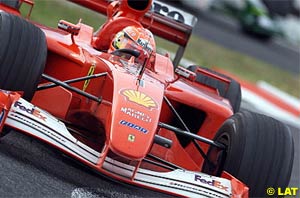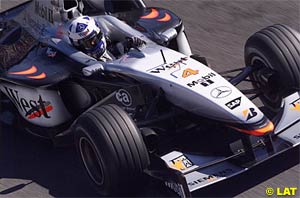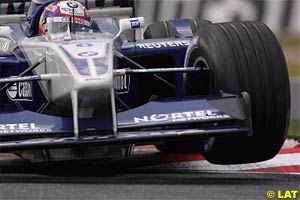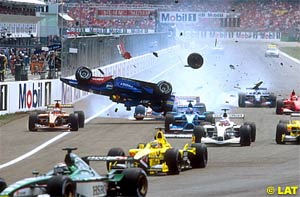
Atlas F1 Technical Writer
Significant aerodynamic changes and the potential development of a tyre war saw the 2001 season begin with optimism for a closer and more exciting racing series than Formula One had seen for a long time. But Ferrari were on top of their game, easily winning both the Drivers' and the Constructors' Championships. Atlas F1's technical writer Will Gray reviews the year
Significant aerodynamic changes and the potential development of a tyre war saw the 2001 season begin with optimism for a closer and more exciting racing series than Formula One had seen for a long time.
The season dawned with McLaren technical director Adrian Newey admitting the latest challenger to be let out of his stable was a complete re-design of the 2000 model because of the effect the new car design regulations had made. Simply raising a front wing 50 millimeters may seem almost insignificant, but it disturbed the entire airflow over the car, and there was plenty of work going on in not only McLaren's wind tunnel, but that of every team preparing to line up on the Grand Prix grid.
Most teams began with front wings that used some sort of solution to benefit from the regulations' allowance of a lower section underneath the nosecone. Several teams simply dropped the centre section down, others did a smoother job with wings drooping in the middle, but Williams, McLaren, Prost and Arrows opened the season with standard mainplanes.
By the end of the season, however, it seemed Williams, who claimed early on that the droop solution did not work with their car, were the only team to stay with a more standard solution. The front wings were subject to constant re-evaluation throughout the season, however, with Benetton's originally sharp solution toned down during the year, and Sauber choosing to move in the opposite direction.
It is now clear that Newey's interpretation of those new regulations led to what was described as an unpredictable car by driver David Coulthard, and left the once-dominant squad from Woking looking over their shoulders at the chasing Williams team rather than battling regularly at the front with the scarlet Ferraris.
But perhaps McLaren's true undoing this season was their inability to cope with the new electronic rules which, because of a late conclusion on their inclusion for 2001, were not introduced until the Spanish Grand Prix, four races into the season.
Before Spain, Coulthard was level on points with Michael Schumacher, and looking every bit the favourite to challenge him for the title. But that was before McLaren's shock failure to cope with the new technologies. The re-introduction of traction control, which had been out of the sport since 1994, was down more to the FIA's determination to combat cheating than to Formula One's desire to remain at the forefront of technology.
Traction control seemed to have little effect for many of the teams, and McLaren's Mika Hakkinen even admitted to turning off his system to get a better lap time in qualifying on the system's debut.
But although paddle shifts were almost consigned to history as automatic gearboxes were made legal, it was the introduction of 'launch control' which in the end seemed to be the undoing of not only McLaren but several other teams on the grid.
In three consecutive races after traction control was legalised, one of the two McLaren drivers was left, embarrassed, sitting on the grid and watching the cars go by after the system decided to cut the engine.
In Mika Hakkinen's case, when he was left petrified on the grid in Austria and was miraculously missed by all of his rivals, it was not the fault of the system, but of the complexity required to operate it. Hakkinen had pressed the wrong button at the wrong time.
The fact that Formula One racing is now started by the push of a button is not a subject for discussion here, but now a good start, as Eddie Irvine commented, is down to fast reactions and a clever engineer back in the garage.
In Austria, a total of four cars were left sitting on the grid after failures in their launch control systems, and it created massive worries for the tight start at Monaco, with the FIA calling for teams to think sensibly and run a standard start procedure if they were unsure of their systems.
The arrival of French tyre manufacturer Michelin on the scene had most definitely stepped up Bridgestone's development of new compounds and new constructions, but after Spain it was clear that the ever-improving Williams team would soon use Michelin's competitiveness to their advantage.
With the help of Sam Michael, who moved to the team from Jordan over the winter to begin his role as operations director, Williams got it together and used the Michelin rubber to full advantage. They were fast, almost from the beginning, but problems with inconsistency, much a part of the tyres but also due to the car's disliking of the slower tracks, hampered their progress and efforts to beat McLaren to second.
Williams designers Gavin Fisher and Geoff Willis certainly created a good car, and although they were forced to change the diffuser at the rear after a rule change made it illegal, they continued to improve and Michelin's development through the season left them expecting victories rather than hoping for them.
That was evident in the performance of the other Michelin-shod teams during the year. In Australia, of the Michelin runners it was only Williams who looked impressive as the rest showed the form many had expected of the French manufacturer as they slumped down and out of the top ten.
But by the end of the season, Michelin had done such a good job at catching up with Bridgestone that the two tyre manufacturers were reasonably evenly spread amongst the top ten, with McLaren switching to French rubber for next season. But along with the excitement of the tyre war, Formula One organisers, the FIA, faced calls for new regulations after lap times in Australia were two seconds faster than pole position last year, and a massive accident in Australia left the Grand Prix world in shock.
The investigation from the FIA yielded nothing other than a satisfaction that speeds were in control, but by the end of the season, further demands on the wheel tethers were introduced for 2002. Other safety improvements, however, were more successful, as Prost driver Luciano Burti proved. His dramatic roll at the start of the German Grand Prix showed that strengthening the roll hoop was a good idea, but worse was to come in Belgium, when a collision with Irvine sent him into the barriers.
The quest for safety, of course, is the most important area of work for not only the FIA but also for the teams, and the relief of everybody in the Spa-Francorchamps paddock when it was revealed that Burti was alive showed what really matters in race car design.
Coulthard, a long-serving member of the Grand Prix Drivers' Association, admitted that only a few years ago Burti would have been killed. And although Ferrari must be praised for their all-conquering machine, and the development of traction control was an important step in the history of the sport's technology, the most important lesson to be learned from Formula One 2001 was that the quest for safety must never stop
 But Ferrari were on top of their game, and despite the introduction of electronic driver aids, and the surprise rapid growth of Michelin as a tyre supplier throughout the season, they could rarely be toppled and have left everyone wondering how they can be overhauled in 2002.
But Ferrari were on top of their game, and despite the introduction of electronic driver aids, and the surprise rapid growth of Michelin as a tyre supplier throughout the season, they could rarely be toppled and have left everyone wondering how they can be overhauled in 2002.
 Early in the season, there were rumours that Ferrari were using some sort of technique to gain extra grip by means of judging wheelspin on the track and limiting the throttle to prevent it - a form of traction control. It was claimed that, if there were such a system, Ferrari's was definitely legal, but it was this type of controversy and confusion which enforced the introduction of a specifically determined type of system.
Early in the season, there were rumours that Ferrari were using some sort of technique to gain extra grip by means of judging wheelspin on the track and limiting the throttle to prevent it - a form of traction control. It was claimed that, if there were such a system, Ferrari's was definitely legal, but it was this type of controversy and confusion which enforced the introduction of a specifically determined type of system.
 Jordan was one team which opted to turn off launch control, and with others following suit, a catastrophe was avoided. But it was McLaren's mini-demise that caught the headlines, and it came at the perfect time for Williams.
Jordan was one team which opted to turn off launch control, and with others following suit, a catastrophe was avoided. But it was McLaren's mini-demise that caught the headlines, and it came at the perfect time for Williams.
 The new regulations for 2001 had called for increased strength in the wheel tethers, which run through the wishbones in the suspension and attempt to tie all four wheels to the car in the case of an accident. But when Jacques Villeneuve was launched into the air after a crash with Ralf Schumacher in the early laps at Melbourne, it was his stray wheel that flew off after the tether was severed, and fatally collided with marshal Graham Beveridge.
The new regulations for 2001 had called for increased strength in the wheel tethers, which run through the wishbones in the suspension and attempt to tie all four wheels to the car in the case of an accident. But when Jacques Villeneuve was launched into the air after a crash with Ralf Schumacher in the early laps at Melbourne, it was his stray wheel that flew off after the tether was severed, and fatally collided with marshal Graham Beveridge.
Please Contact Us for permission to republish this or any other material from Atlas F1.
|
Volume 7, Issue 44
Articles
Jean Alesi: One in a Million
Commentary
Reflections on 2001
2001: Rubber and Class
A Season in Waiting
2001 Season Review
The End of Season Report
The 2001 Technical Review
The 2001 Season in Quotes
How Would F1 Score in Other Series
Columns
The 2001 Qualifying Differentials
2001 Season Strokes
The Weekly Grapevine
> Homepage |